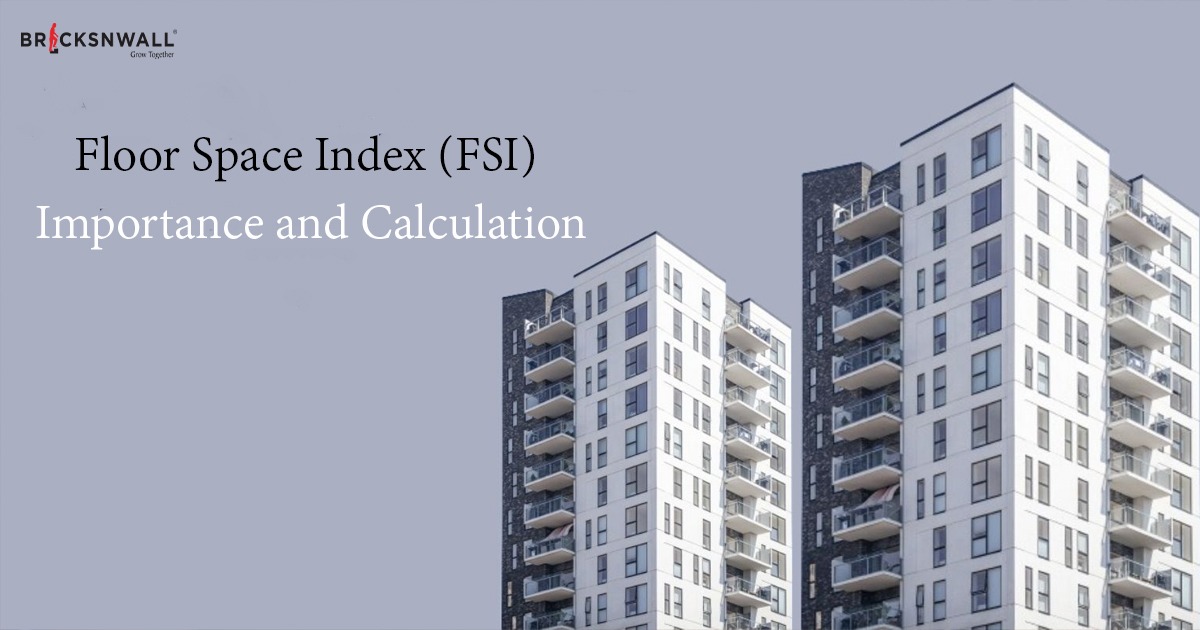FSI: What is it?
Bricksnwall Trusted Experts

The Floor Space Index (FSI) is a key concept in real estate. FSI determines the maximum amount of construction allowed on a plot of land based on its size. It is calculated by dividing the entire floor area of a building by the area of the land.
Since FSI aids in regulating urban development, it
is crucial to comprehend it. Authorities can manage infrastructure capacities,
regulate building densities, and preserve an area's general equilibrium by
imposing restrictions on FSI. Buildings are not packed, and FSI ensures there
is enough open space for facilities and public use.
For instance, a plot with an FSI of 2 indicates
that the building's total floor area cannot be greater than twice the plot's
size. This cap helps preserve a peaceful urban environment by preventing
overbuilding.
Zoning laws and urban planning both heavily rely on
FSI. It guarantees that structures are built in compliance with the resources
and infrastructure that are available, including transportation networks,
energy, and water. Developers can support well-planned and sustainable urban
growth by following FSI requirements.
How Can I Do an FSI Calculation?
A simple FSI formula is used to perform FSI
calculations. Developments, authorities, and property owners can determine the
maximum amount of construction that can be done on a specific piece of land by
using the FSI calculation.
The total covered area of all floors divided by the
plot area is the FSI. Here's an example to show how it works:
Assume that the building's total covered area,
including all floors, is 750 square meters, and that the land plot is 500
square meters. The FSI can be computed by dividing the total covered area (750)
by the plot area (500).
FSI is calculated by dividing Total Covered Area by
Plot Area. 750 square meters divided by 500 square meters is the FSI. FSI is
1.5.
This instance reveals that the FSI is 1.5. It recommends that the structure's overall floor area not surpass 1.5 times the plot's size. If the FSI allowed by local law is 2, the building can be further expanded to utilise the available FSI.
Premium FSI: What is it?
Another idea associated with Floor Space Index
(FSI) in real estate is Premium FSI. If a charge is paid, it permits developers
to beyond the typical FSI limits. Beyond standard FSI, premium FSI offers the
possibility of more construction rights. Consequently, developers are able to
create bigger structures and make the most of a plot.
Premium FSI is significant since it generates
income and aids in urban development. Authorities can raise extra money by
providing premium FSI, which can then be used for projects like public
facilities or infrastructure development. Additionally, it gives developers
flexibility when creating their construction blueprints.
For developers hoping to increase a project's potential revenue, Premium FSI might be a helpful tool. It allows them to add more stories or increase the building's size, which would allow them to add more apartments or business areas. Higher rental income or property values may result from this, increasing returns on investment.
How Can I Calculate Premiums for FSI?
Calculating Premium FSI entails a procedure that is
comparable to that of ordinary FSI computation, but it also accounts for the
premium cost. To demonstrate the calculation, consider the following example:
Let us assume that you have a 500 square meter parcel
of land with an FSI limit of 2. You must pay a premium fee if you wish to use
premium FSI and go over the standard FSI limit. Let's say that the premium cost
is 10,000 rupees per square metre.
To find the normal FSI, first multiply the plot
area by the FSI limit:
Plot Area x FSI Limit = Regular FSI
500 square meters x 2 is the regular FSI
A typical FSI is 1000 square meters
The premium FSI can then be found by deducting the
ordinary FSI from the desired total FSI:
Total FSI minus Regular FSI equals Premium FSI.
Assume that a total FSI of 1500 square meters is
what you desire. FSI's premium would be:
The premium FSI is 1500 square meters less 1000
square meters.
Five hundred square meters is the premium FSI.
Finally, to calculate the premium cost, multiply
the premium FSI by the premium charge rate.
Premium FSI x Premium Fee Rate = Premium Fee
The premium fee is equal to 500 square meters times
10,000 rupees every square metre.
The premium fee is fifty million rupees.
Therefore, by paying the premium cost, you can use an additional 500 square meters of building over the typical FSI limit..
Elements That Impact FSI
The maximum amount of development that is allowed on a piece of land is determined by a number of criteria that affect the Floor Space Index (FSI).
The following five major elements impact FSI:
Zoning Regulations: Local governments' zoning
regulations are a major factor in determining FSI. For particular zones or
areas, these regulations specify acceptable land use, building setbacks, height
limitations, and FSI limits. The zoning regulations that apply to a specific
plot have an impact on the FSI calculation.
Infrastructure Capacity: The availability and capacity of infrastructure systems are also impacted by FSI. This covers public facilities, transit networks, sewage systems, and water supply systems. Authorities take into account whether the infrastructure can accommodate more building. When determining the FSI limits, it then considers the influence on the surrounding region.
Aspects of the Environment: Aspects of the
Environment: FSI may be impacted by environmental considerations as ecological
areas, open space needs, and environmental impact studies. In order to maintain
environmental sustainability and safeguard natural resources, authorities may
enforce regulations or allot more FSI.
Road Width and Setbacks: FSI may be impacted by building setbacks and the width of nearby roads. FSI limitations may be lowered by narrower roadways or greater setbacks.
The building's access, parking, and
circulation would all be guaranteed, and broader roadways might permit higher
FSI.
Building Type and Function: The kind of building and its intended use may have an effect on FSI.. Depending on local laws, FSI limitations for institutional, commercial, industrial, and residential structures may change. For instance, compared to residential properties, commercial buildings may be permitted to have higher FSI.
advantages of comprehending FSI
For those working in real estate, knowing the Floor Space Index, or FSI, has many advantages.
Here are a few main benefits:
Property Evaluation: Accurately assessing a
property's development potential is made possible by knowledge of FSI for
investors and prospective buyers. They can evaluate the viability of their
proposals by knowing the maximum permitted density and construction. As a
result, they are better equipped to determine and project possible returns on
investment and make wise choices.
Regulation Compliance: FSI assists property owners and developers in adhering to regional building and zoning laws. They can design and develop structures that follow the criteria by being aware of the FSI rules. Consequently, avoiding fines and guaranteeing legal compliance.
Optimal Land Use: By regulating construction
density, the Floor Space Index makes it possible to use land effectively.
It guarantees the prudent use of available land by striking a balance between
the demands of infrastructure, open spaces, and amenities and the demands of
development. Gaining an understanding of FSI aids in making the most use
of the available space.
Sustainable Development: In order to support sustainable urban development, FSI is essential. FSI makes guarantee that urban areas are built in a way that supports infrastructural capacity and conserves resources by controlling building density and size. It aids in preserving equilibrium between population expansion and the facilities that are accessible.
Making Well-Informed Decisions: Comprehending All
parties involved are empowered by FSI to make knowledgeable choices about real
estate investments and building projects. It enables people to comprehend the
opportunities and constraints related to a specific property.
In conclusion
Anyone working in the real estate industry has to understand FSI. It offers information on the potential for development, adherence to rules, and best use of the land that is available. Understanding every facet of the query "What is FSI?" makes it simpler to reach real estate objectives, make wise judgements, and support sustainable urban growth.







